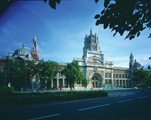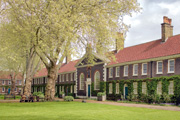The Enduring Legacy of William Morris
Originally published in October 2014 in American in Britain magazine Autumn 2014
One of the greatest Victorian artist-craftsmen and visionaries, William Morris (1834- 1896), is the subject of the current exhibition at the National Portrait Gallery. Fiona MacCarthy, the biographer of Morris and design historian, has curated a show that looks far beyond his wallpaper and textile designs.
The Enduring Legacy of William Morris
By Abby Cronin ‘Have nothing in your houses that you do not know to be useful, or believe to be beautiful.’ William Morris lecture, ‘The Beauty of Life’, 1880 One of the greatest Victorian artist-craftsmen and visionaries, William Morris (1834- 1896), is the subject of the current exhibition at the National Portrait Gallery. Fiona MacCarthy, the biographer of Morris and design historian, has curated a show that looks far beyond his wallpaper and textile designs. In Anarchy & Beauty: William Morris and His Legacy, 1860-1960, MacCarthy has drawn on her vast knowledge of Morris, his circles and politics to tell a story of networks and influences through key narratives from 1860 to 1960. The story follows William Morris’s influential ideals of ‘art for the people’ into the 20th century and asks the question: What relevance does his visionary thinking have on art and design, the ethics of work, distribution of wealth and responsibility for the natural environment? The exhibition illustrates how his values have influenced and were integral to the philosophy and practice of the Pre-Raphaelites, Socialism, and the Arts and Crafts movement. In the early years of the 20th century his ideals inspired the Suffragette movement, Garden City pioneers, the 1951 Festival of Britain and post-war designers such as Terence Conran. (1) William Morris was the eldest son of a large wealthy middle -class family. His childhood years were spent in the east London suburb of Walthamstow in a home imbued with a spirit of the Middle Ages, simple furnishings and holidays spent in idyllic rural surroundings. The influence of these early years sowed the seeds of a profound appreciation for the beauty of nature. As he matured, Morris became a passionate advocate of ‘art for the people’: Men should be free to pursue their natural curiosity and to work with nature. Such was his revulsion for the soulless, repetitive and dehumanising practices he saw in the factories and cities of industrial Britain that he became involved in the struggle to change the whole basis of society, expressed so clearly in his visionary novel News From Nowhere, (1890). It was through the Pre-Raphaelite Brotherhood, formed in the years after 1857, that many fellow artists shared his reverence for the purity of medieval arts and excellence in craftsmanship. Members of the PRB (Pre-Raphaelite Brotherhood) included Burne-Jones, Rossetti, Faulkner, the architect Philip Webb and Ford Maddox Brown. When they gathered at Red House, the first marital home of William and Jane Morris, they shared these ideals and exercised their unique creativity in designing, furnishing and decorating the home. They made exceptional pieces of medieval painted furniture. One of the most remarkable examples is the Prioress’s Tale Wardrobe, (1859), which Burne-Jones decorated with episodes from Chaucer’s ‘Prioress’ Tale’ for the bedroom apartment. The only completed painting of his wife by Morris, La Belle Iseult (1858), portrays Jane in a stylised medieval dress. New concepts of beauty in design and styles of decoration evolved as the PRB engaged in furnishing the Red House. Furniture was rugged and simple, and women were encouraged to be creative partners in the process. Jane embroidered and her sister became a skilled wood engraver. Women were now co-workers, a core principle in the Arts and Crafts movement from the 1890s onward. It is hardly surprising that Morris saw the beginnings of a decorating business taking shape as the architecture and interiors of the Red House were completed. Perhaps it is somewhat incongruous that, as the decoration scheme in the Red House evolved, it was the antithesis of simple. There were multiple patterns, colour upon colour, elaborate hand-blocked wallpapers, stained glass, tiles and metalwork. Everything was handmade. Morris was so enthusiastic about the furnishings for the Red House that he went on to establish his own decorating business. Known as ‘The Firm’, Morris, Marshall, Faulkner & Co was set up at 8 Red Lion Square when the family moved back to London in 1865. The business grew and was reconstituted under Morris as Morris & Co. when it moved to 449 Oxford Street in 1877. The company flourished and continued to follow the design principles of medieval-inspired handcrafted items for the home. It was best known for specialising in stained glass, metalwork, carving, wallpapers, carpets, printed textiles and furniture. (2) It is hardly surprising that Morris was unable to bring good design within reach of the working classes. Quite simply, he was a meticulous craftsman whose designs were too costly for most people. His clientele was largely drawn from the enlightened middle classes and aristocrats. Nonetheless, he did achieve a revolution in taste by raising people’s awareness and appreciation of what had been considered ‘the lesser arts’ such as textiles, metalwork, weaving, ceramics, carving, publishing, bookbinding and even calligraphy. The importance of these so-called ‘lesser-arts’ is much appreciated today. There are several examples of valued handmade objects in the exhibition. An exceptionally beautiful example of the art of bookbinding is Morris’s own well-thumbed copy of Karl Marx’s Capital. It is in the exhibition in a gold-tooled binding by T.J.Cobden-Sanderson, (1884). Many more were produced by the Kelmscott Press, which Morris established in 1891, notably the Kelmscott Chaucer. Unable to see any progress towards eliminating class distinctions, Morris actively embraced socialism from the mid-1880s. MacCarthy explains: “In embracing socialism Morris had quite consciously moved beyond the familiar confraternities of the Arts and Crafts movement and the Society for the Protection of Ancient Buildings into a different and more unsettling world, in which accepted values, political and sexual, behavioural and spiritual, were always being questioned. Morris was now in with the humanists and naturalists, Theosophists, sexologists and psychical researchers, suffragists and feminists….”(3) Although Morris played a major role in the Socialist League, it lacked a coherent political position and had only a tiny membership. When the Red House was sold in 1865 due to financial difficulties, Morris’s home, Kelmscott House in Hammersmith, became a focus of socialist activity. Fellow artists like Walter Crane supported the Socialist League with designs for the membership card, a series of pamphlets, essays and banners. Others espoused unorthodox sexual lifestyles and established communal collectives. Edward Carpenter, known as ‘the Saint in Sandals’, lived communally with workmen and women in Millthrope, a cottage in a small agricultural village, where he developed sandal making into a successful cottage industry. C.R. Ashbee opened the Guild and School of Handicraft in the East End of London in 1888. But in 1902 he moved some 150 people to a rural setting in Chipping Camden in the Cotswolds in order that these craftsmen and women could improve their living and working conditions. Ashbee aimed to provide employment for the poor and they flourished in Chipping Camden as jewellers, silversmiths, and enamellers, furniture-makers and so much else. The pursuit of the ideal society was central to the Garden City movement. Morris wrote: “I want neither the towns to be appendages of the country, nor the country of the town…..” (4) Land was acquired in 1903 for Letchworth in Hertfordshire, the first garden city. The architectural plans of C.F.A.Voysey influenced the designs for Garden City homes. They were planned to be simple, gabled slate-roofed cottages paired together so that they would re-create an old village charm. As the Garden City movement progressed, Heal & Sons saw a retailing opportunity for the manufacture of beds, mattresses and simple furniture well suited for such houses. Long after his death in 1896, Morris’s radical thinking continues to influence many aspects of the arts and politics. Among his many supporters were Sylvia Pankhurst, one of the leading women in the suffragette movement and Ambrose Heal, whose handmade furniture still flourishes. In the post-war years, gifted potters such as Bernard Leach and women textile designers like Lucienne Day inspired contemporary ceramicists and fabric designers. Day’s’ ‘Calyx’ textile is still available today. Morris’s political influence is evident in the Fabian Movement*, the emergence of the Labour Party and the post-war Atlee Labour Government. The 1951 Festival of Britain, a regenerative project of the post-war Labour government, was a major stimulus for mid-twentieth century designers. ‘There is no logical reason’, Gordon Russell argued in the publication Design in the Festival, ‘why well-designed things should not be available to all of us.’ (5) Today we see excellence in design all around us. Conran’s furniture and domestic products demonstrate how good design can be both cost-efficient and sold on the high street. Although Morris’s ideal of ‘art for the people’ exemplifies the tension between anarchy and beauty, his visionary thinking– his creative anarchy– has endured. It provides a rich landscape for maintaining high standards of good design for the public and understanding the importance of caring for the natural environment. Exhibition – Anarchy & Beauty: William Morris and His Legacy, 1860-1960 Enduring Legacy of Wm Morris-Sept-2014Enduring Legacy of Wm Morris-Sept-2014National Portrait Gallery www.http://npg.org.uk/ Exhibition Dates: 16 October 2014 – 11 January 2015 Catalogue: Anarchy & Beauty: William Morris and his legacy – 1860 – 1960 By Fiona MacCarthy. Yale University Press 2014 All images Courtesy of the National Portrait Gallery *The Fabian Movement: http://en.wikipedia.org/wiki/Fabian_Society
Notes from exhibition catalogue:
-
catalogue p.164
-
catalogue p 28
-
catalogue p.38
-
catalogue p. 94)
-
catalogue p.117
Contact: Abby Cronin. Email artsjournalist@abbycronin.co.uk
Website – http://www.abbycronin.co.uk
I would like to hear from you–comments and suggestions




